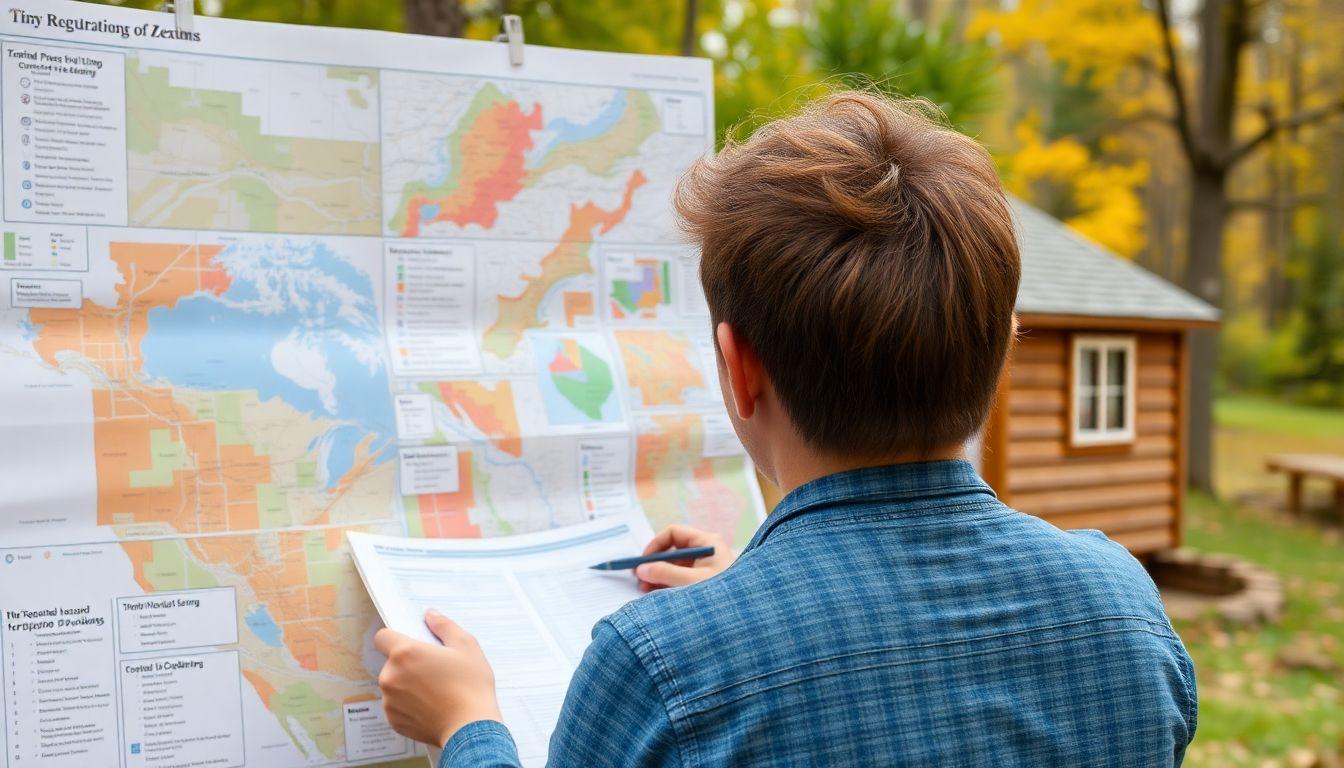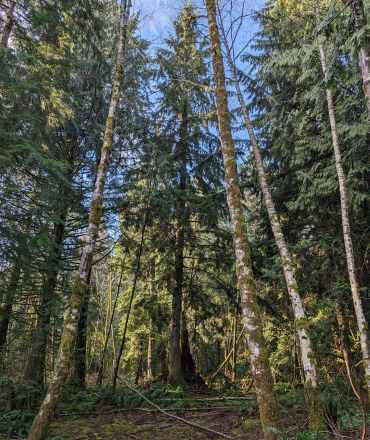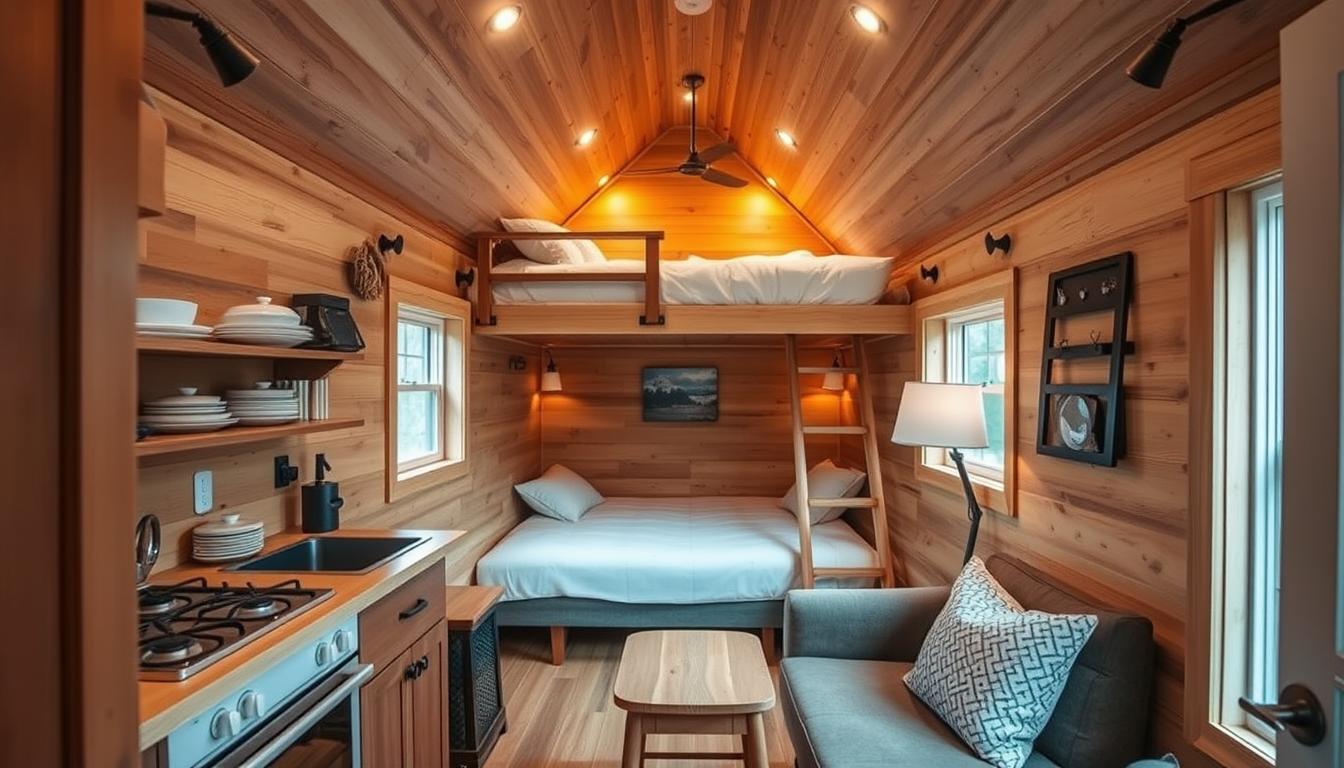Are you considering building a tiny house on land? This guide will help you navigate the process, offering steps to create a cozy, affordable home while embracing a minimalist lifestyle and achieving financial freedom. With rising living costs, many individuals and families view tiny homes as a practical solution. Here, we’ll outline essential steps to successfully build and enjoy your tiny house on land, highlighting community, collaboration, and sustainable living.

Learn About Tiny House Living
Discover essential insights and practical tips for successfully building a tiny house on land tailored to your needs.
– Understand the significance of researching local zoning laws and regulations to ensure compliance and secure necessary permits for your tiny house project.
– Gain insights on selecting suitable land, considering factors like utilities and zoning, and explore options for purchasing or leasing land for your tiny house.
– Learn about budgeting effectively, sourcing sustainable materials, and navigating the construction process, including utility installations and interior design tips for optimal space utilization.

Research Zoning and Regulations for Tiny Houses on Land
Understanding Local Zoning Laws
Before starting your tiny house journey, research local zoning laws and regulations that may affect your plans. Zoning laws govern how land can be used, determining if you can legally build a tiny house on a specific plot. For instance, Laura, a tiny house owner from Oregon, discovered that her desired plot was in an area with strict zoning laws, which initially discouraged her. However, she attended local meetings and advocated for tiny homes, ultimately helping to change local regulations.
Common restrictions include:
- Minimum Dwelling Size: Many areas impose minimum size requirements for homes, which could exclude tiny houses.
- Land Use Designations: This indicates whether the land is for residential, commercial, agricultural, or other uses.
- Setback Requirements: These rules dictate how far structures must be from property lines, roads, and water bodies.
Navigating Zoning Requirements
Here are tips for navigating zoning requirements and obtaining necessary permits:
- Contact Local Authorities: Reach out to your local zoning office or planning department for specific information about regulations.
- Attend Local Meetings: Community meetings can help you learn about changes in zoning laws and voice support for tiny house developments.
- Consult Professionals: If navigating the bureaucracy feels overwhelming, consider hiring a land use attorney or consultant who specializes in tiny homes.
Understanding and adhering to local regulations helps you avoid legal issues and ensures a smoother building process.

Find Suitable Land for Your Tiny House
Key Factors in Land Selection
Finding the right piece of land is crucial when building a tiny house on land. Consider these factors:
- Location: Assess proximity to work, schools, and healthcare. Rural areas may offer affordable options, but consider the trade-offs in amenities.
- Access to Utilities: Ensure the land has access to essential services like water, electricity, and sewage. If not, explore the feasibility of installing these utilities.
- Size and Terrain: A tiny house requires minimal space, but consider the terrain. Flat land is easier to build on, while unique landscapes provide stunning views.
Finding Affordable Land
Here are tips for finding affordable land suitable for your tiny house:
- Explore Alternative Options: Look for land through auctions, foreclosure sales, or online marketplaces. Websites like Zillow and Craigslist can yield results.
- Consider Shared Land: Collaborating with others to purchase larger plots can reduce costs and foster a sense of community.
- Long-term Leases: If buying land isnt feasible, consider long-term leasing options for flexibility and lower initial costs.
Personal Journey: From Dream to Reality in Tiny House Living
Discovering the Dream
When I first stumbled upon the concept of tiny house living, I was captivated by the idea of simplicity and sustainability. After years of renting and feeling like my money was disappearing into someone else’s mortgage, I decided to take the plunge. My name is Sarah Thompson, and in 2021, I embarked on a journey to build my own tiny house on a small plot of land in rural Oregon.
Navigating Zoning Laws
Before I could break ground, I had to navigate the local zoning regulations. I remember feeling overwhelmed as I sifted through the local government website, but I found it crucial to understand what was allowed. I discovered that my chosen plot was zoned for residential use but needed a few permits, including a building permit and a septic system approval. I reached out to the local planning department and scheduled a meeting, which proved invaluable in clarifying requirements and timelines.
The Right Land
After securing the necessary permits, I focused on finding the right land. I wanted a peaceful location, but I also needed access to essential utilities. After months of searching, I found a half-acre lot with a beautiful view of the mountains, just a 15-minute drive from town. It was perfect! I negotiated a lease option with the landowner, allowing me to affordably secure the property while I built my tiny home.
Building the Dream
The construction phase was labor-intensive, but I was committed to using sustainable materials. I spent hours sourcing reclaimed wood and eco-friendly insulation. I learned so much during this process, including the importance of proper insulation for my tiny homes energy efficiency. Each step, from laying the foundation to installing the roof, was a learning experience that made me feel more connected to my new lifestyle.
Moving In
Finally, in early 2022, I moved into my completed tiny house. The excitement was palpable as I unpacked my belongings and personalized my space. I designed my tiny home with multifunctional furniture that maximized every inch. Living in my tiny house has not only reduced my living expenses significantly but has also given me a profound sense of freedom and fulfillment.
Conclusion
Reflecting on this journey, I encourage anyone considering tiny house living to embrace the challenges. From understanding zoning laws to designing a personalized living space, each decision is a step toward a simpler, more sustainable lifestyle.
Zoning for Residential Use
Once you find a potential plot, confirm it is zoned appropriately for residential use. Check with local authorities or land use maps to ensure your dream location can legally accommodate your tiny house.

Designing Your Tiny House on Land
Personalizing Your Tiny Home
When building a tiny house on land, design is critical to your comfort. Start by determining your specific needs and preferences. Consider:
- Size: How much space do you need? Tiny homes range from 100 to 400 square feet, depending on your lifestyle.
- Layout: Think about how you want to use the space. Open floor plans can make small areas feel larger, while defined rooms offer more privacy.
- Style: From modern to rustic, the style of your tiny house should reflect your personality.
Optimizing Space and Light
To maximize your tiny houses potential, consider these design tips:
- Multi-functional Furniture: Invest in furniture that serves multiple purposes, such as a sofa bed or a foldable dining table, to save space.
- Natural Light: Incorporate large windows or skylights to enhance natural light and create an airy feel, making your tiny home feel more expansive.
- Sustainable Design: Use eco-friendly materials and energy-efficient designs to lower your environmental footprint and utility costs.
Creating a Budget for Your Tiny House Project
Establishing a Realistic Budget
Creating a budget is essential when building a tiny house on land. Start by estimating all potential costs:
- Materials: Research costs for wood, insulation, roofing, and other building materials. Websites like HomeAdvisor can provide estimates and comparisons.
- Permits: Include the costs of permits and inspections required by local authorities.
- Labor: If you plan to hire professionals, get quotes from contractors to understand labor costs.
Accounting for Unforeseen Expenses
Set aside a contingency fund for unexpected expenses that may arise during construction. A cushion of about 10-20% of your total budget helps alleviate stress and keeps your project on track.
Tips for Cost Savings
To save money during construction, consider these strategies:
- DIY Projects: If skilled, take on certain aspects of construction yourself, like painting or landscaping.
- Buy in Bulk: Purchasing materials in bulk can lead to significant savings.
- Community Resources: Look for local groups or forums to find used materials or tools at a lower cost.
Gathering Building Materials and Tools
Selecting Sustainable Materials
Choosing the right materials is crucial for durability and sustainability when building a tiny house on land. Focus on materials that are affordable and eco-friendly. Consider options like:
- Reclaimed Wood: Ideal for framing and finishes, its both sustainable and aesthetically pleasing.
- Insulation: Look for energy-efficient insulation materials for comfort year-round.
Essential Materials List
Heres a detailed list of materials needed for each stage of construction:
| Stage | Materials |
|---|---|
| Foundation | Concrete, gravel, or treated wood |
| Framing | Lumber, screws, and nails |
| Roofing | Shingles, metal sheets, or tiles |
| Utilities | Pipes, wiring, and fixtures for plumbing and electrical systems |
| Interior Finishes | Drywall, flooring, cabinets, and paint |
Sourcing Affordable Materials
To source high-quality building materials affordably:
- Local Suppliers: Visit local hardware stores or lumberyards for discounts or deals.
- Salvage Yards: Check salvage yards for reclaimed materials. You can find unique items that add character to your tiny house.
- Online Marketplaces: Websites like Facebook Marketplace or Craigslist can be excellent resources for finding used materials.
Building Your Tiny House on Land
Step-by-Step Construction Process
Building your tiny house involves several critical steps:
- Site Preparation: Clear debris and level the ground where the house will sit.
- Foundation Construction: Choose a permanent foundation (like a concrete slab) or a mobile option (like a trailer).
- Framing: Construct the frame of your tiny house using gathered materials. Ensure everything is square and level.
- Roofing: Install the roofing material, ensuring its watertight.
Safety Precautions and Building Codes
Throughout construction, prioritize safety and compliance:
- Safety Gear: Always wear appropriate safety gear such as gloves, goggles, and hard hats.
- Building Codes: Familiarize yourself with local building codes to ensure compliance.
Hiring Professionals
If construction feels daunting, consider hiring professionals or seeking help from experienced builders. This can ensure your tiny house is built safely and correctly. For example, Mark, who built his tiny house in Colorado, hired a contractor for electrical and plumbing work to ensure everything was up to code.
Installing Utilities in Your Tiny House
Connecting Essential Utilities
Once the structure is complete, connect essential utilities, including:
- Electricity: Work with a licensed electrician to ensure your electrical system is safe and compliant with local codes.
- Water: Connect to municipal water lines or consider installing a rainwater harvesting system for sustainability.
- Sewage Systems: Research local regulations regarding sewage disposal. Options may include septic systems or composting toilets.
Consulting Professionals
Consulting professionals for utility installations is highly recommended. They can ensure that all systems are installed safely and up to code, minimizing future issues.
Off-Grid Utility Options
For a more sustainable lifestyle, consider off-grid options for utilities, such as:
- Solar Power: Installing solar panels can provide renewable energy for your tiny home.
- Rainwater Collection: Setting up a rainwater collection system can reduce reliance on municipal water.
- Composting Toilets: These eco-friendly toilets can eliminate the need for a traditional sewage system.
Interior Finishing of Your Tiny House
Creating a Comfortable Living Space
The interior finishing of your tiny house is crucial for comfort. Focus on these aspects:
- Insulation: Proper insulation keeps your tiny house cozy. Consider spray foam or rigid foam insulation for optimal results.
- Flooring: Choose durable and visually appealing flooring options, such as bamboo or laminate, which can withstand wear while adding warmth.
Smart Storage Solutions
Maximizing space in your tiny house is essential. Here are some smart storage solutions:
- Built-in Shelving: Use vertical space by installing shelves that reach the ceiling.
- Under-bed Storage: Utilize the area under your bed for additional storage, whether its drawers or bins.
- Multi-functional Furniture: Consider furniture that serves multiple purposes, such as ottomans with storage or foldable tables.
Personalizing Your Space
Don’t forget to personalize your tiny house! Incorporate your style through:
- Color Schemes: Choose colors that make the space feel bright and welcoming.
- Artwork and Decor: Add personal touches with artwork, plants, and decor that reflect your personality.
Exterior Finishing and Landscaping for Your Tiny House
Completing the Exterior
Once the interior is finished, focus on the exterior of your tiny house, including:
- Siding: Choose materials like wood, metal, or vinyl that suit your style and climate.
- Roofing: Ensure the roofing is durable and weatherproof.
- Windows and Doors: Install energy-efficient windows and doors that enhance your homes aesthetics.
Enhancing Curb Appeal
To boost curb appeal, consider landscaping and outdoor living spaces:
- Gardens: Plant native flora that require minimal maintenance and attract local wildlife.
- Patios or Decks: Create outdoor spaces for relaxation and entertainment by adding a patio or deck.
Ongoing Maintenance
Regularly maintain the exterior of your tiny house for longevity. Check for signs of wear and perform necessary weatherproofing to protect against the elements.
Finalizing Inspections and Certifications
Importance of Inspections
Before moving into your tiny house, schedule inspections to ensure compliance with building codes and regulations. Inspections can cover:
- Structural Integrity: Ensuring the house withstands environmental factors.
- Utility Connections: Verifying that electrical, water, and sewage systems are safely installed.
Obtaining Certifications
After passing inspections, you will receive necessary certifications and approvals, such as:
- Occupancy Permit: This allows you to legally reside in your tiny house.
- Insurance Approval: Proper documentation is essential for obtaining homeowners insurance.
Benefits of Completing Inspections
Completing inspections offers several benefits:
- Safety: Ensures your tiny house is safe for occupancy.
- Legal Compliance: Helps avoid fines or legal issues in the future.
- Insurance: Many insurance companies require proof of inspections before providing coverage.

Moving In and Enjoying Your Tiny House on Land
The Excitement of Moving In
Congratulations! Youve successfully built your tiny house on land. The excitement of moving in is unparalleled. Youll quickly discover the joys of tiny house living, including:
- Lower Living Costs: Reduced mortgage or rent payments can free up your budget for travel, hobbies, or savings.
- Simplified Lifestyle: Living in a smaller space encourages decluttering and prioritizing what truly matters.
Personalizing Your Space
As you settle in, take time to personalize and organize your space. Consider:
- Functional Layouts: Arrange furniture to maximize functionality and flow.
- Decor Choices: Add personal touches that reflect your style while maintaining a cozy atmosphere.
Embracing Sustainable Living
Living in a tiny house allows you to embrace a more sustainable lifestyle. You can enjoy reduced energy consumption, a smaller carbon footprint, and the ability to live more intentionally. Celebrate your new way of life by connecting with nature and your community.
Conclusion
Building a tiny house on land is a transformative journey toward affordable and sustainable living. By following the steps outlined in this guidefrom researching zoning laws to finalizing inspectionsyou can create a cozy home that reflects your lifestyle and values.
Embrace the numerous benefits of tiny house living, including lower expenses, a simplified lifestyle, and a profound connection to your environment. As you embark on your tiny house adventure, stay informed about local regulations, prioritize your personal preferences, and imagine the rewarding, minimalist lifestyle that awaits you.
We invite you to continue your exploration! Dive into our additional resources for more tips and insights on building a tiny house on land. Check out our guides on zoning laws, affordable land options, and design ideas. Happy building!
Questions & Answers
Who can help me with building a tiny house on land?
You can hire contractors or consult tiny house builders for assistance.
What permits do I need for building a tiny house on land?
You typically need zoning and building permits depending on your location.
How much does it cost to build a tiny house on land?
The cost varies, but it can range from $20,000 to $100,000 or more.
Can I build a tiny house on land without experience?
Yes, many resources and workshops are available to guide beginners.
What size should I consider when building a tiny house on land?
A tiny house is generally under 400 square feet, but size varies by need.
How do I handle objections about living in a tiny house?
Focus on benefits like lower costs, sustainability, and minimalism.
With over a decade of experience in sustainable architecture and tiny home design, the author is a recognized expert in the field of affordable living solutions. Holding a Masters degree in Environmental Design from the University of California, Berkeley, and having completed a certification in Tiny House Construction from the National Association of Home Builders, they bring a wealth of knowledge to the topic. The author has been featured in publications such as Dwell and Tiny House Magazine, and has contributed to research on zoning regulations for alternative housing, including a study published in the Journal of Urban Planning. Their hands-on experience includes designing and building multiple tiny homes across various states, which provides practical insights into navigating local zoning laws and selecting suitable land. Passionate about sustainable living, they also serve as a consultant for prospective tiny house builders, helping to turn their dreams into reality.










